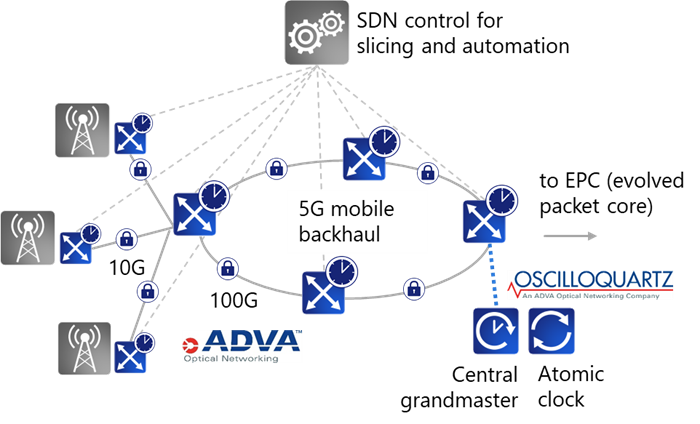Communication service providers are adopting a range of approaches to 5G. Some are focusing on fixed wireless access as a substitute to copper or fiber transport. Others see huge opportunities in accessing sensors with new narrowband radio access technologies such as NB-IoT and LTE-M. There is also great value in end-to-end virtualization, aka slicing, for offering customized private mobile networks to enterprises and governments.
Combining several emerging 5G capabilities will provide an even stronger business case, especially if such solutions address a widely applied application. Let’s have a look at an IoT use case with requirements typical for many other IoT applications.
With border and area surveillance solutions, information from geographically dispersed monitoring systems is processed by a central command and control center. Here the data is analyzed, critical activities are identified and required action is initiated. The value of 5G can easily be understood by comparing a previously deployed solution with a 5G-based implementation.
Critical area surveillance as typical IoT use case
A fence is an effective tool for blocking access to critical areas. However, it can easily be overcome. Acoustic and seismic sensors in combination with fence monitoring systems and multi-spectral cameras can provide a way to detect access attempts at an early stage. This can trigger countermeasures from authorities, preventing unwanted access. All of these systems require connection to a central command and control center. While some sensors provide a very low volume of data, perhaps only a few bits per second, others, such as video with high-resolution, can consume Mbit/s. Authorities need to communicate through a mobile system.
Previously, what was needed to meet all communication requirements was a UHF system for access to sensors in combination with microwave point-to-point and point-to-multipoint systems for backhauling video traffic, and professional mobile radio for mobile communication. This type of customer-specific solution demands a great deal of system integration effort as well as high operational costs for maintaining different network technologies. Public mobile networks would not even be considered for this task, as they would not be able to provide sufficient capacity for video signals, mobile coverage to access remote sensors or meet the necessary privacy requirements.
5G changes everything
In the above example, a range of different wireless network technologies had to be applied in order to connect sensors, cameras and police staff with a central site. The emergence of 5G enables several radio technologies to be combined in order to cater for a wide range of wireless access scenarios. Narrowband radio systems can gather sensor data, high-capacity fixed wireless solutions can connect high-resolution cameras, and low-latency access to mobile users enables even time-critical processes to be remotely controlled.
This next-generation mobile technology comes as a single family of radio technologies, minimizing the previous need for time-consuming integration of single-purpose, siloed solutions. 5G network slices also create closed, private user groups for enterprises and governments. This meets their requirement for private networks connecting users, computers and devices. What’s more, virtualization avoids the expensive construction of parallel networks.
The connectivity layer in 5G networks
A mobile network is built on a high number of base stations connected to an evolved packet core (EPC). With 5G, the number of base stations will significantly increase to accommodate more user equipment as well as increased bandwidth requirements. This increases the bandwidth per radio site from several hundred Mbit/s to multiple Gbit/s, creating the need for fiber optic access. Today’s 1Gbit/s and 10Gbit/s backhaul networks will also move towards 100Gbit/s aggregated bandwidth.
Network slicing enables a single physical transport network to provide a virtual connectivity network to different user groups and applications. Provisioning of virtual connections, however, adds operational complexity and so automated operation building on centrally controlled SDN is essential.
The privacy and integrity of any mobile communication needs to be secured. Encryption of any connection in the mobile backhaul network is a very efficient way to prevent attacks at the lowest network layer.
Edge computing will widely be applied in 5G networks for low response times and to meet the need for data processing at the edge of the mobile networks. NFV is the technology to provide this capability. Applied with edge compute nodes, mobile operators can flexibly extend their service offering with customer-specific, low-latency data-processing services near the data source.
The connectivity network is also used to distribute highly precise synchronization information using Precision Time Protocol (PTP) IEEE 1588. Grandmasters as sources of accurately time-stamped PTP packets can be located centrally. They receive precise time information from enhanced primary reference time clocks (ePRTCs), which combine atomic clocks with high-performance satellite receivers. As accuracy recruitments increase, the grandmasters will need to move closer to the radio base station.
For cost optimization, radio base stations will be simplified and functionally reduced to remote radio heads connected with a fronthaul network to a centrally hosted base band unit using CPRI (a high-bitrate transport of digitized radio baseband signals). In order to reduce the required bandwidth and to enable standard interfaces to be utilized, eCPRI standardization was initiated with the aim of using Ethernet connectivity, however in a time-sensitive variant for so-called mid-haul transport.

ADVA has a strong track record with optical and packet transport networks including SDN and NFV technologies as applied in 5G backhaul networks. The SDN-controllable packet transport devices cover bandwidth requirements from 1Gbit/s to several 100Gbit/s and allow hosting of VNFs on pluggable servers. Those products are nicely complemented by a full range of optical transport products, designed for multi-Tbit/s transport in the mobile core as well as CPRI transport in the radio access network. Encryption of all connections secures the network from malicious activities. ADVA’s Oscilloquartz division offers the widest portfolio of timing solutions, specifically designed for high precision requirements in 5G. ADVA is the only company offering this unique mix of products and capabilities.
